This June update is rather saddened somewhat as we learnt that Donald Campbell’s widow, actress and singer Tonia Bern-Campbell had passed away this month and our sincere condolences go out to all of her family and friends at this sad time. Tonia and Donald married in 1958 after a whirlwind romance of only knowing each other a few days. He first saw her performing at the Savoy Hotel in London and Tonia clearly brought glamour to Donald’s record breaking career. She was nicknamed ‘Fred’ by Donald’s team and she put her career on hold to be by his side for the rest of his record breaking endeavours with his Bluebird car and jet hydroplane. The following photo shows Tonia and Donald with Bluebird K7:
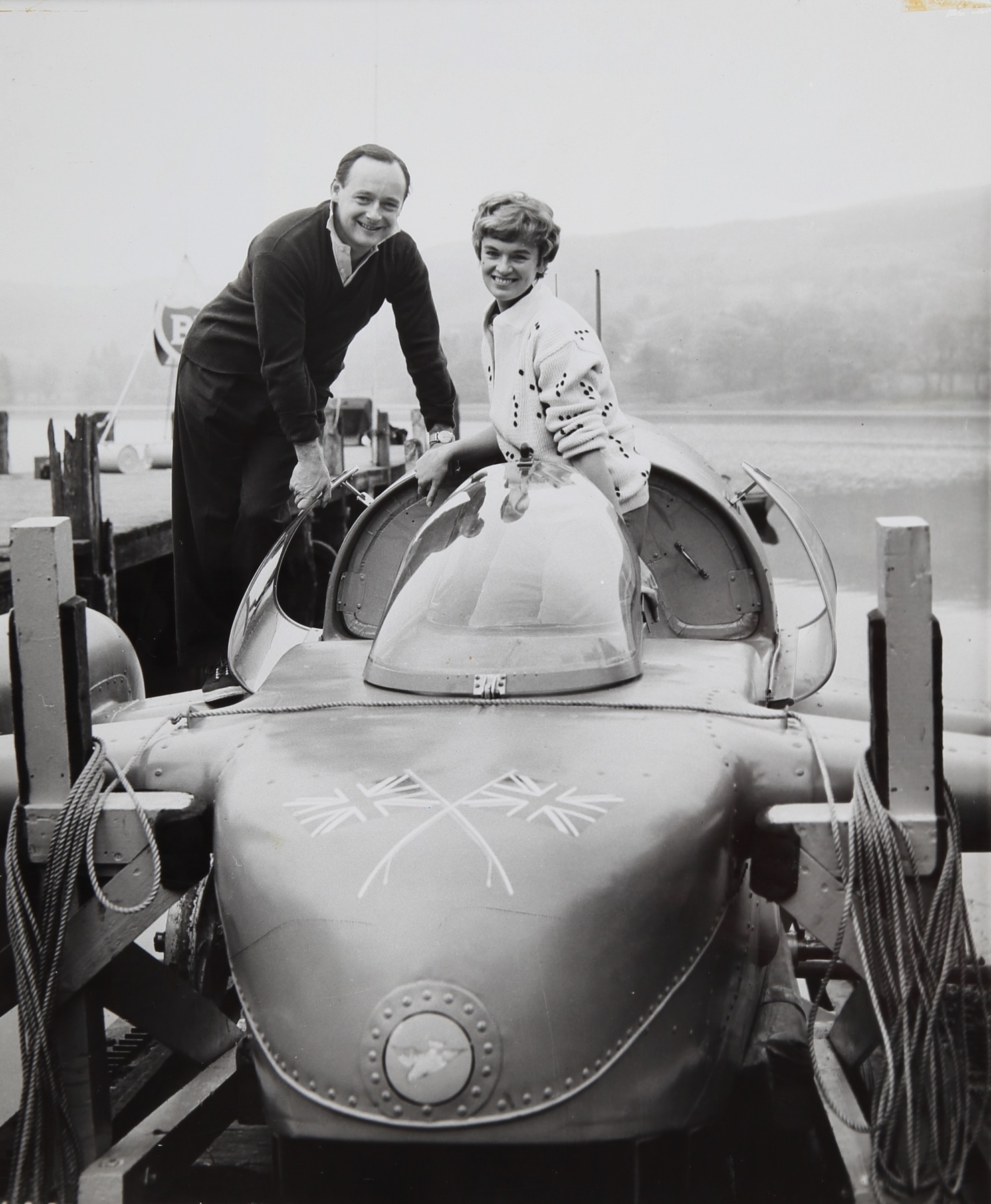
With kind permission of The Campbell Family Heritage Trust
We are led to believe that it was Tonia’s wish to be laid to rest at Coniston where Donald is buried and his Bluebird K7 jet hydroplane is to be put on permanent display by her owners at the Ruskin Museum for the benefit of the Nation.
Looking for instances of twin engine gas turbine hydroplanes I stumbled upon the following story which may be of interest to those following the venture and it concerns a hydroplane built in the USA for the Unlimited class of racing in the 1970’s.
Whilst we are now used to seeing Unlimited class hydroplanes being powered by gas turbines driving a propeller this was not always the case. Up until the 1970’s the Unlimited class of racing hydroplanes in the USA typically used highly tuned military WWII aircraft V12 piston engines such as the Rolls Royce Merlin or Allison. It was the terrific noise these huge aero piston engine craft made, especially when running together in a race that termed the phrase ‘Thunderboats’.
Then along came an innovative businessman called Jim Clapp who commissioned legendary hydroplane hull constructor Ron Jones to build a new Unlimited class boat to be called U-95 for the next season’s racing. What made this boat so unique for the time was Jim managed to obtain a special dispensation by the sport’s governing body to allow him to power the new U-95 using gas turbines rather than V12 piston engine.
The powerplant chosen by Jim was twin Lycoming T-53 gas turbines that were used in helicopters (famously the Huey of the Vietnam War) and other aircraft of that period. The two engines drove a specially made gearbox that in turn spun a single propeller and that gearbox alone was reported to have cost $250,000 which is fair amount of money these days let alone back then. Each of these turbines developed 1700 hp yet weighed only 465 lbs. So with this twin gas turbine combination you had a total of 3400 hp for only two thirds of the weight of a single Merlin / Allison V12 engine. Yet the V12’s even in highly tuned state were making 1000 hp less than this twin gas turbine combination! A photo of U-95 in the foreground with her engine covers removed and also out on the water is shown as follows.
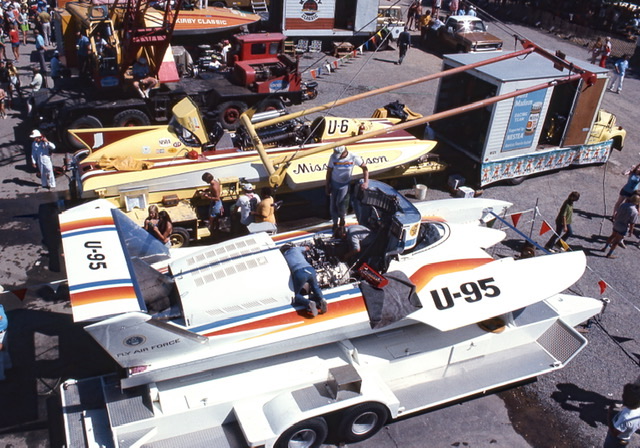
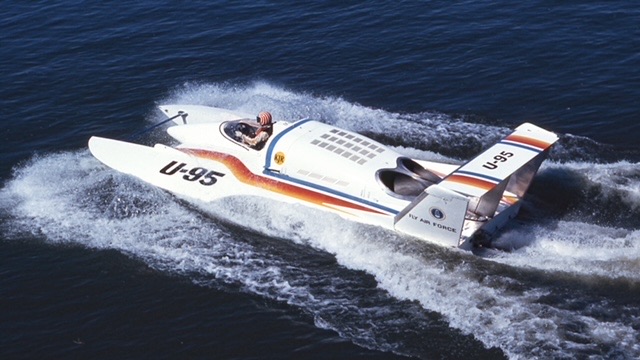
With kind permission of The Hydroplane & Raceboat Museum
Whilst the boat went on to be a winner that sparked the change from piston engines to gas turbines in the Unlimited class of racing that we see today, it was during a race in 1974 that the U-95 came to grief when one of its turbine wheels failed. The exploding spinning metal fragments had enough kinetic energy not only to escape through the side of the engine casing and come out through the engine covers, they also spun out in all the other directions including the underside of the hull and nearly cut the boat in two, with the other engine sat next to the failed one probably saving complete separation of the hull. Not surprisingly the hydroplane then sank but fortunately the unhurt driver Leif Borgersen was able to climb out of the open cockpit before it did so.
As a result of this incident the Unlimited hydroplanes now use a Kevlar blanket wrapped around the turbine sections to try and contain a turbine disc failure and it may be worth us considering such a feature within Longbow to counter such a risk albeit hopefully a small one.
The U-95 was later recovered, repaired and her twin gas turbines were replaced with a single Allison V12 for the 1975 season. As far as I know she was last raced in 1983 under the name of Executone. Of note the special gearbox for the twin turbines was donated by Jim’s widow after he passed away to the Hydroplane and Raceboat Museum in the USA. Whilst there were other gas turbine powered hydroplanes before the U95, they were not actively raced in the Unlimited class, nor had the success that U95 did and it was this boat that really was the start of gas turbines being used to power the craft as a replacement to the limited WWII V12 aero engines, though many will say they miss the sight and sound of the thunderboats racing compared to the gas turbines in use today.
Anyway back with Longbow and this month saw the fairing coat of WEST SYSTEM Epoxy from our sponsor Wessex Resins sanded sufficient to receive paint as shown in the following photo:
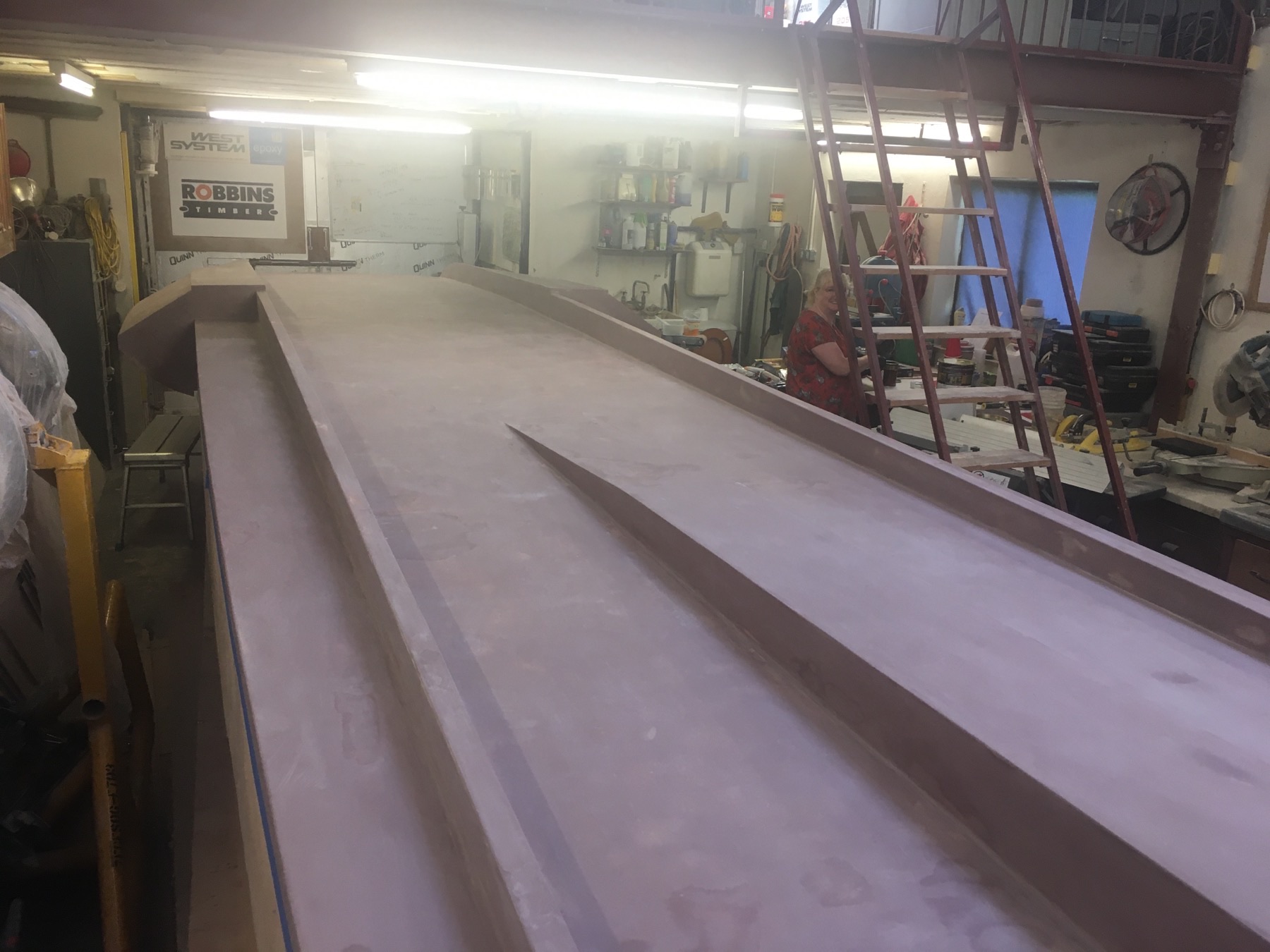
We then took delivery of the primer paint and associated product from our sponsor HMG paints and were very grateful for the expert technical advice received from them via Tony O’Connor and John Fenton.
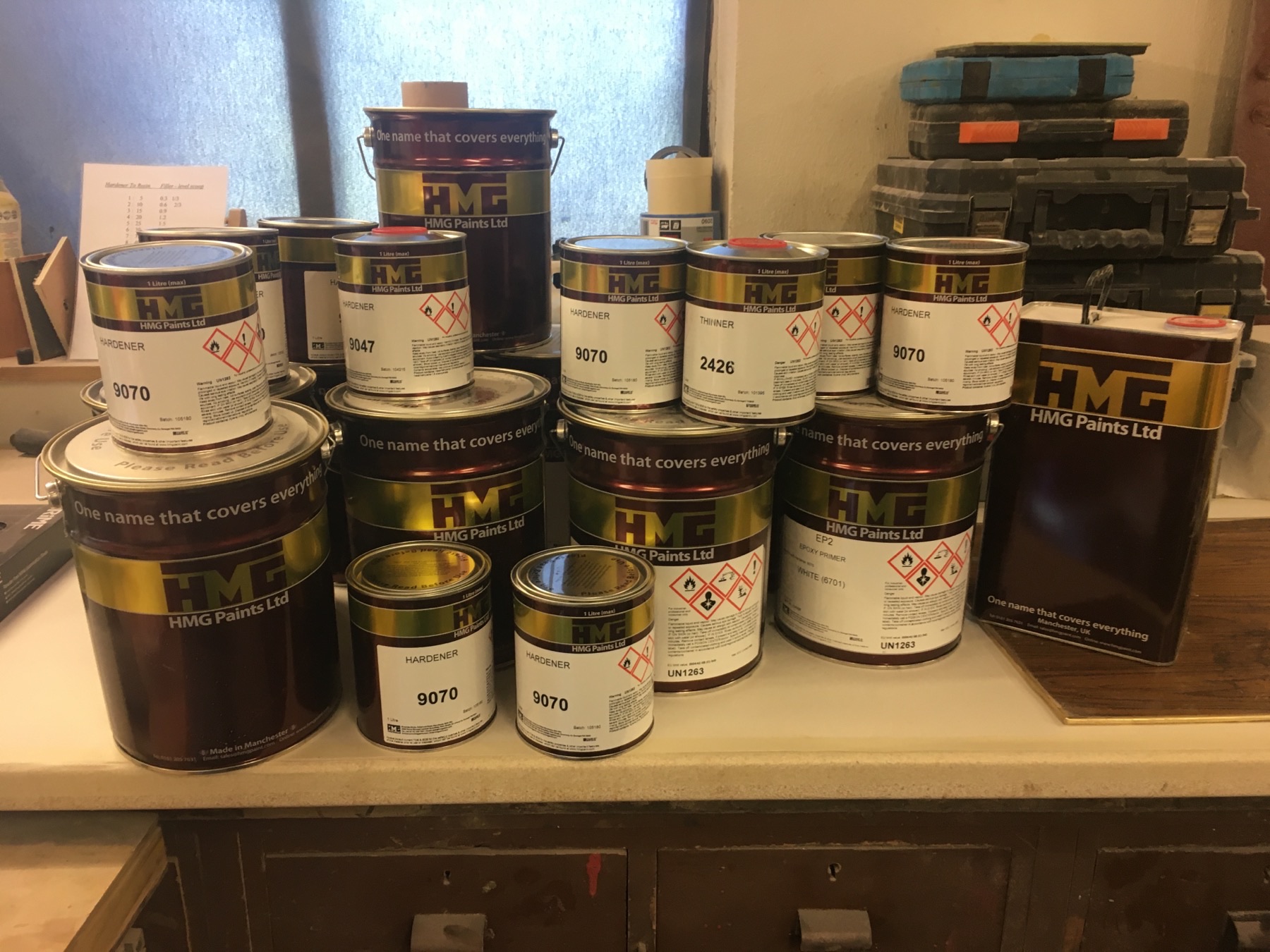
With everything cleaned down I did the first run of primer and after allowing it sufficient time to dry down we were back to sanding once more. This took me back to when as a young man I used to re-paint cars I was renovating in my spare time at my parents house; an example of which is as follows with one of my little Mini Coopers that I should have hung onto given how much they are now worth.
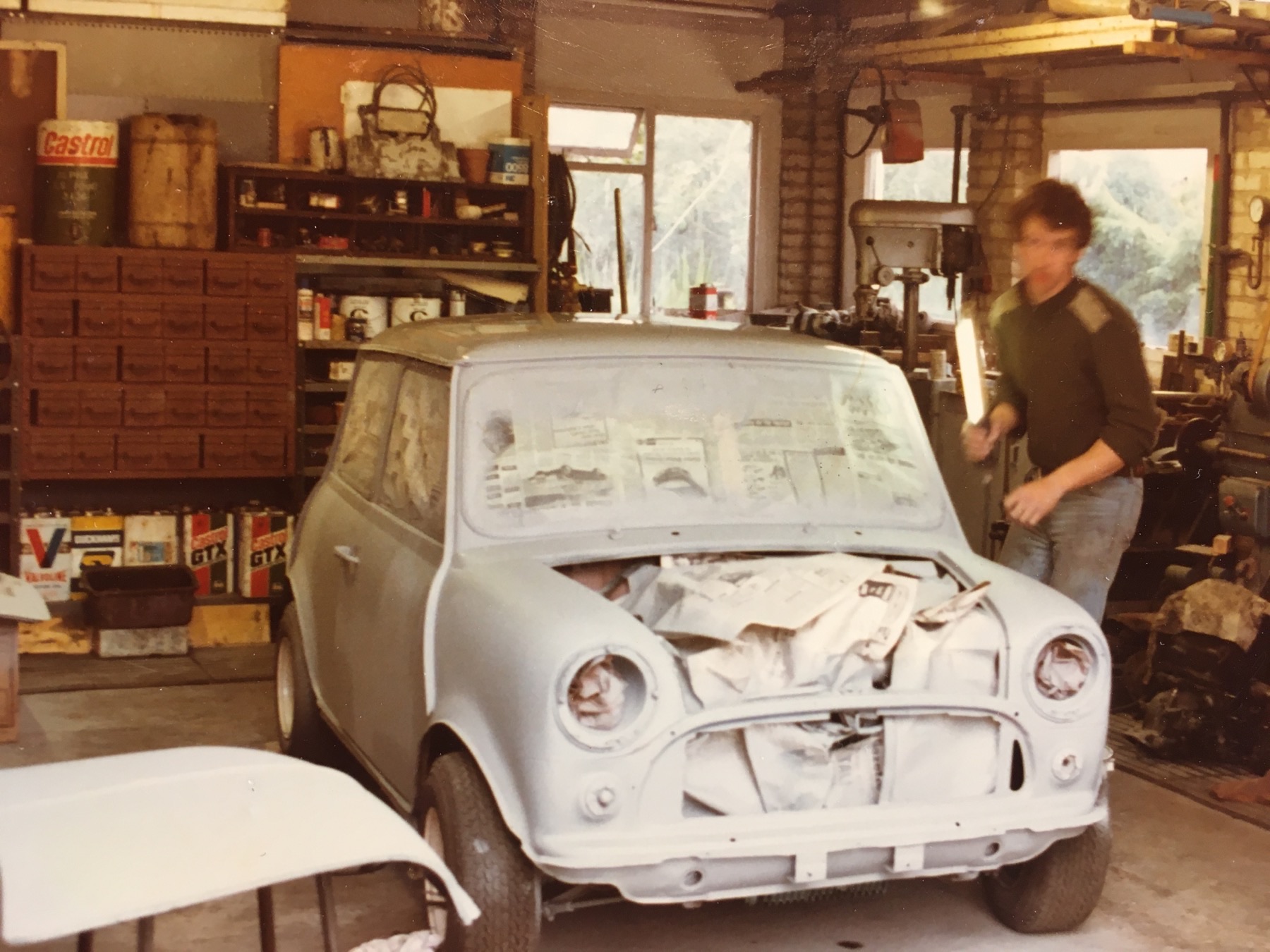
Many thanks to Steve Buckle Marketing Manager of Sealey Tools for their ongoing fantastic support of the venture by way of supplying us this month with an electrical DA sander and buffing machine along with different grade mops and polishing fluids.
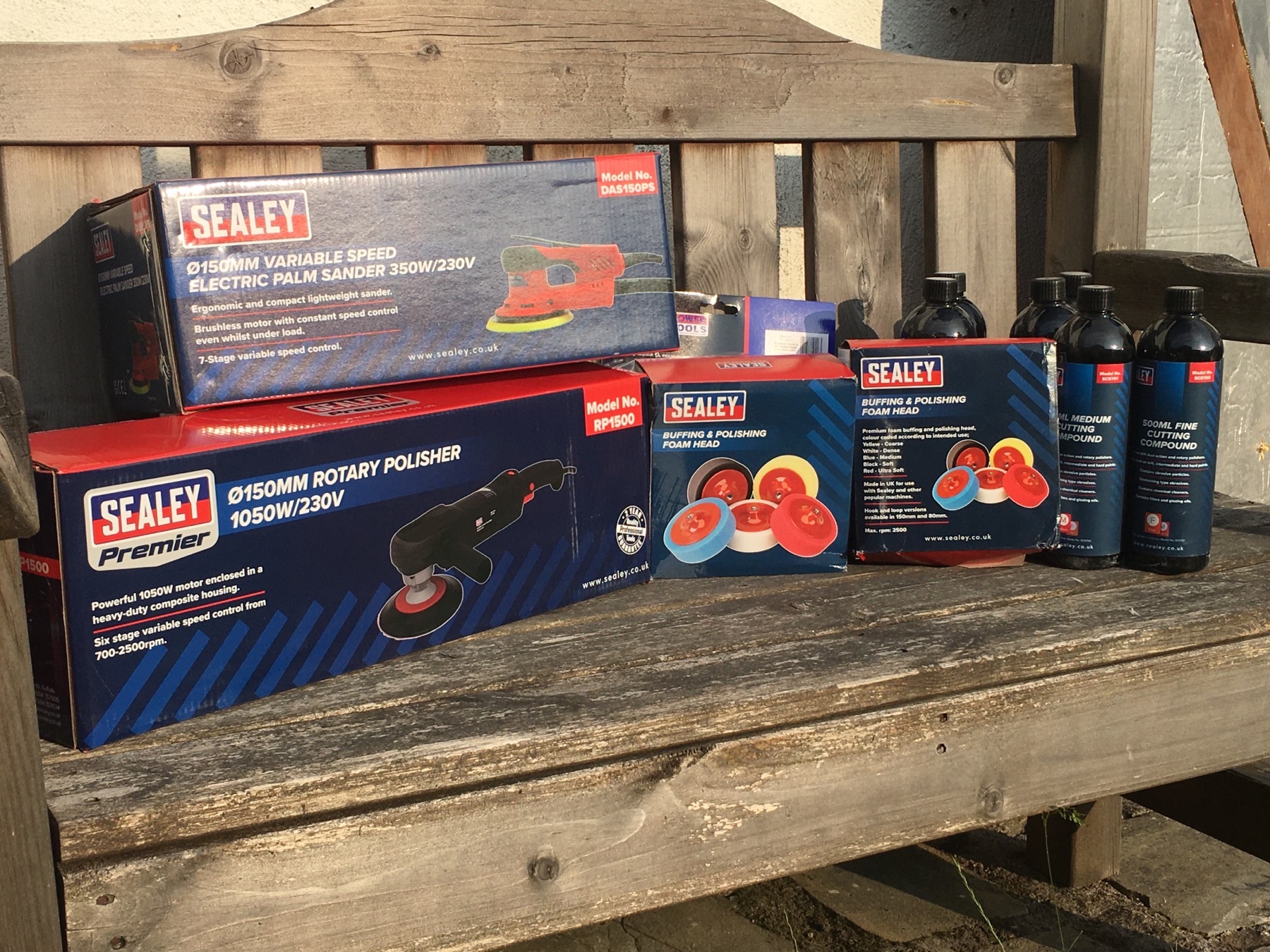
When rubbing the primer down especially when it is a white colour as in this case it can be difficult to see the high and low spots on the paint surface. As an aid with this challenge you can purchase what is called guide coat which comes as either a paint spray or powder that you apply to the surface of the primer and sand away merrily with areas that remain with guide coat showing as low spots that you want to try and get down to.
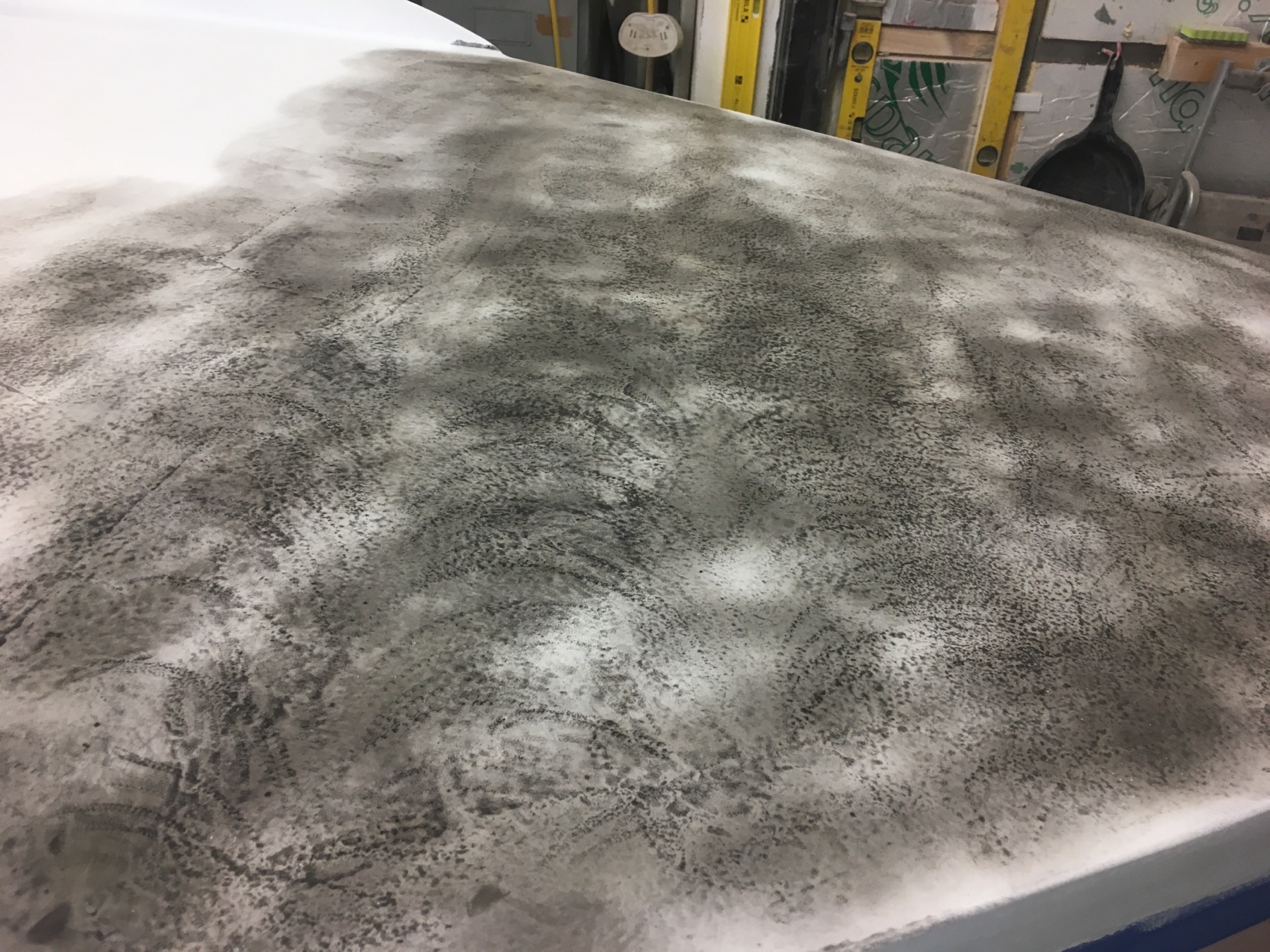
Alternatively but probably less as effective is just to use a joiner’s pencil to strike over the surface and again where the pencil line remains as you sand they are your low spots.
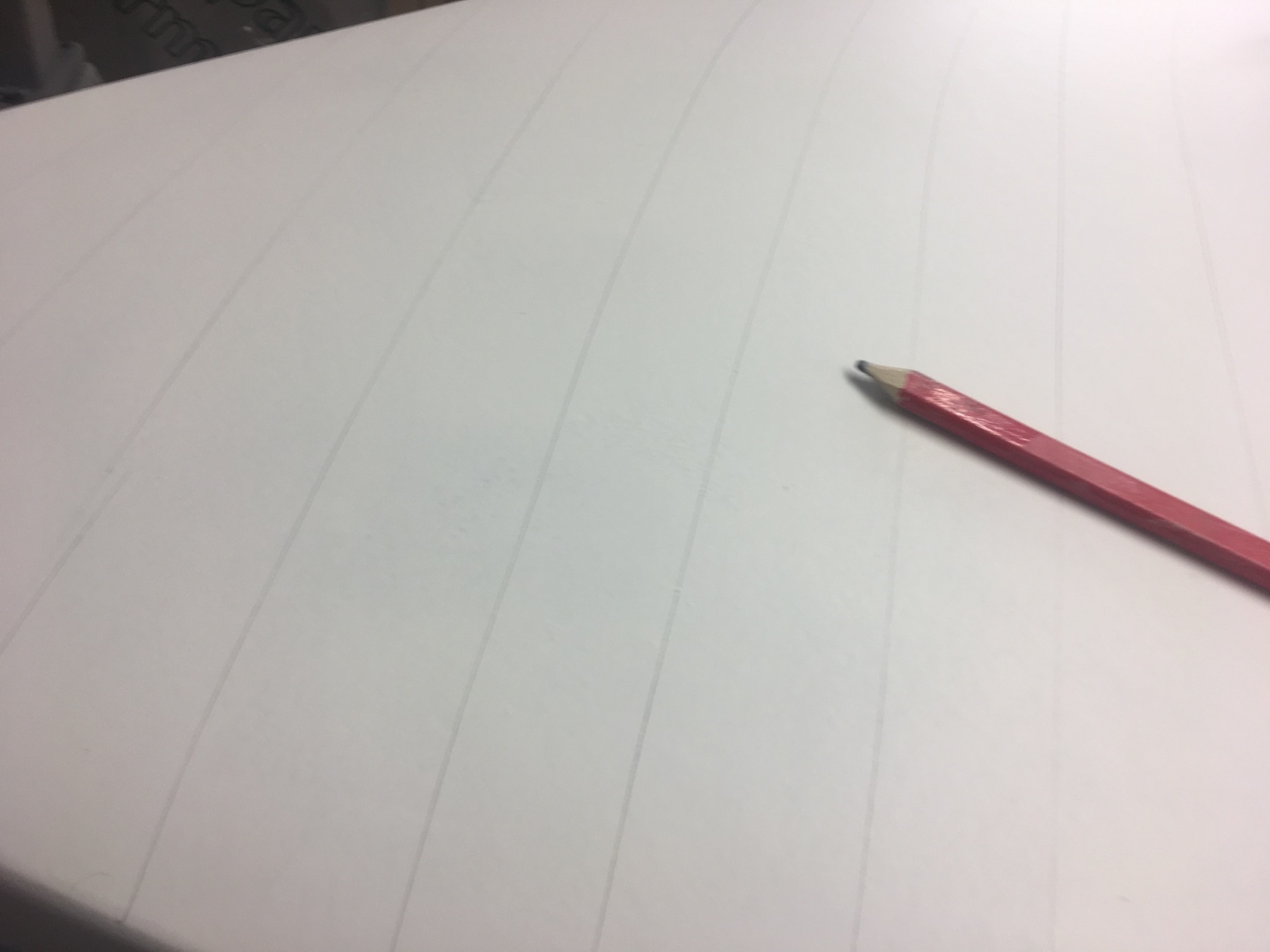
When I ordered the paint I envisaged having to apply filler to some areas but with patience and a lot of sanding it proved better to really just keep applying primer coats and build up any low spots that way even though it was more labour intensive to do so.
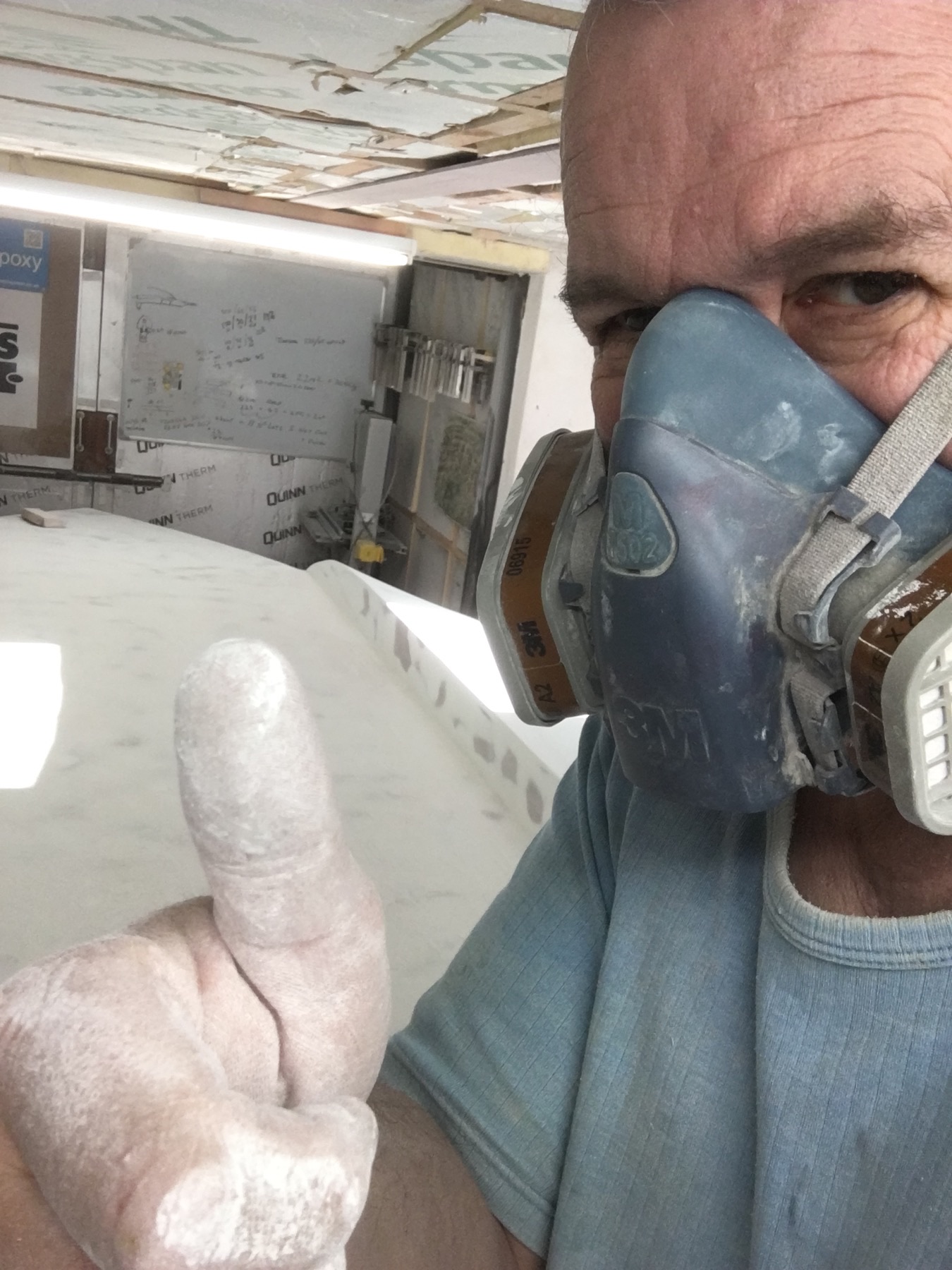
When I have painted cars in the past I used to do it by spray application but even then doing it without a spray booth and extractor system was something of a nightmare because the more you do in one session the more it just starts to hang in the air. So not only do you end up with whatever colour you are spraying covering everything in the workshop and I do mean everything, you also end up not being able see how the paint is going on the car from the spray gun.
So when it came to Longbow I just knew spraying the underside of the hull to paint that area was going to be a non starter in such a confined space as the problems mentioned above would just be magnified. Yet I had to paint this area before I could get the inverted hull off the build table it is currently sat upon and turn her over to go onto the trailer for the rest of the build to continue. Once she is the right way up then for any further painting that will be required I will have the option to transport her to a decent paint spraying facility but for now the underside had to be painted in the workshop. Accordingly for the reasons stated the only other option to spraying was to hand paint by roller. That way all of the paint would go on the hull rather than a significant amount going airborne.
So that is what I opted to do for the underside area, roller by hand. On the subject of rollers for this task I found the short pile mohair rollers work better than the foam type as the latter tends to disintegrate part way through the task. In case you didn’t know true mohair is hair from Angora goats and is naturally very absorbent with smooth fibres just what you want for painting. A little tip just before you start is to wrap the mohair roller in sellotape or similar and then remove so it takes any loose fibres away with the sticky tape rather than they appear on the hull during paint application.
Anyway with time, dust and lots of patience I am getting there as shown in the following photo of the underside of Longbow now in HMG primer.
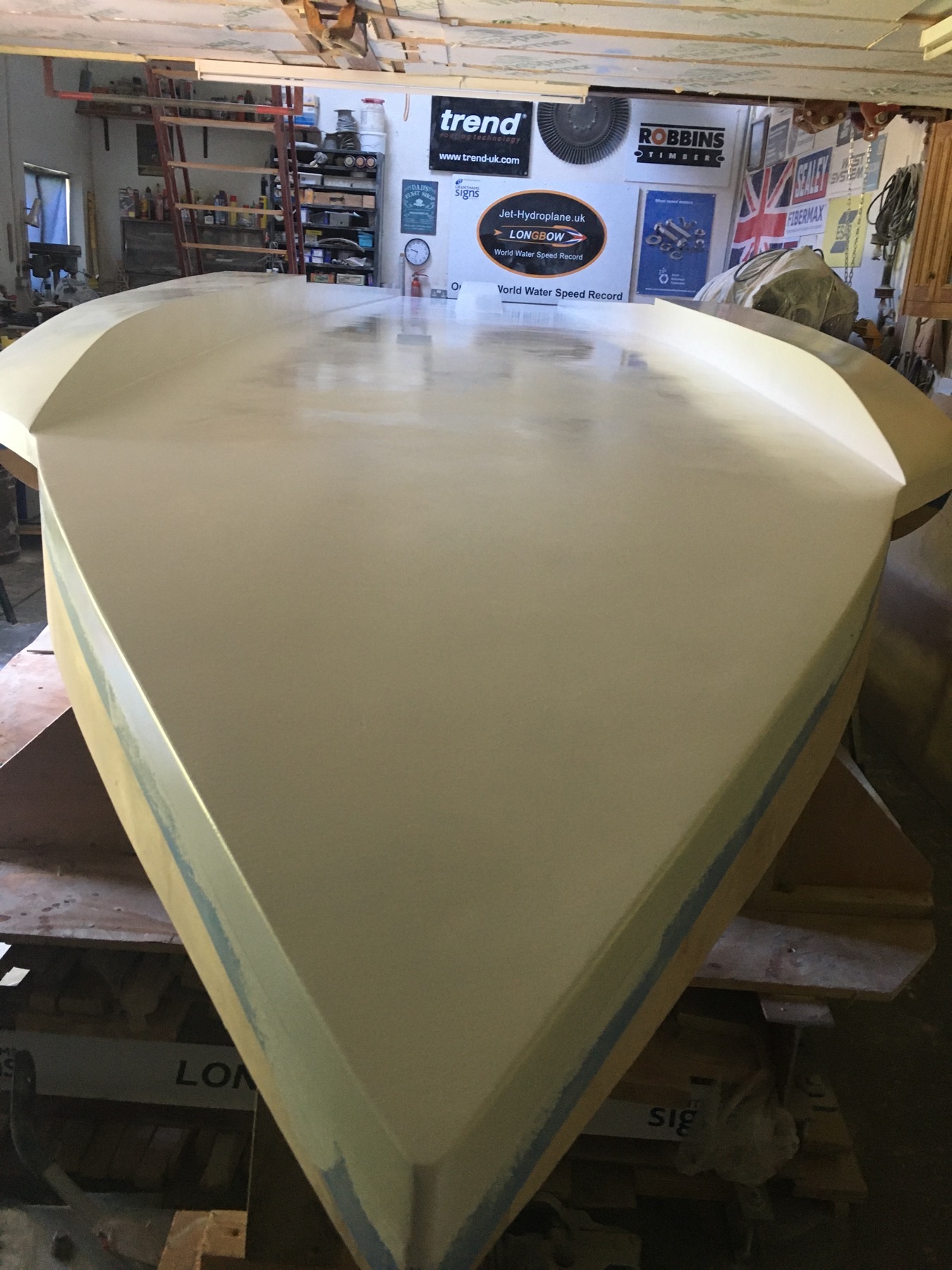
Hopefully we will be able to begin applying colour shortly which I hope you will like because it has already arrived from HMG so there is no going back now!
In other news the plastic planks to form the bunks for the trailer for Longbow have now arrived from our sponsor TDP and the stainless fixings to bolt them in place on the trailer have also just arrived from our sponsor Avon Stainless Fasteners Ltd so hopefully I can get those fitted shortly too.
Well that is all the news that I have for you this month folks. Please drop by towards the end of July for the next diary update of the venture and if you have not done so yet then please take a moment to like our Facebook page as a means of keeping in touch with our little project.
